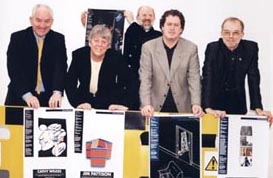

Campus Developments
Those based on the main campus could be forgiven for thinking that this has been a 'quiet' year for campus expansion. Most of the construction programme has involved behind the scenes work within existing buildings.

Visual Research Centre
The city’s £9 million Centre for the visual arts, Dundee Contemporary Arts (DCA), regarded as the keystone in Dundee’s new ‘cultural quarter’, opened in March 1999. It is expected to become a regular haunt of students and staff visiting the cafe/restaurant, two screen cinema and art exhibitions. At the heart of its hands-on ‘see the artist at work’ philosophy, is the University’s Visual Research Centre. Equipped with £600,000 of the latest high-tech kit, the Centre has cutting edge facilities for artists to produce prints, catalogues, CD Roms and 3-D models from computer drawings and videos.
Psychology
Even the only new building currently under construction - an extension for Psychology - is not apparent from most directions being tucked out of sight behind its home in Scrymgeour and Dundee Rep.
Geotechnical Centrifuge Centre
The new £0.5 million centrifuge, housed for safety reasons in a one foot thick concrete and steel casing, is the first of its kind in Scotland and one of only twelve in Europe. The Centre’s staff, led by Professor Michael Davies, expect the facilities to be of particular interest to off-shore and environmental engineers. Initial projects for the centrifuge include two funded by the European Union.
New Law Centre
The Centre for Professional Legal Practice will specialise in providing professional practice courses for lawyers and non-legal professionals as well as overseeing the established full-time Diploma in Legal Practice. Copyright, charity law, employment law, contracts, liability, negotiation and ethics are some of the many topics in which tailor-made courses can be offered at the Centre or in-house. When opening the Centre, Lord Ross, formerly Lord Justice Clerk, spoke of "yet another example of the innovative approach in the training of lawyers at the University of Dundee".
Biomodelling
A major new Centre - the first of its kind in Scotland - to apply mathematical modelling techniques to biomedical processes was announced by the Scottish Higher Education Funding Council (SHEFC). The £1 million Scottish Informatics Mathematics Biology and Statistics Centre (SIMBIOS) will involve collaboration between Dundee and Abertay universities.
Tayside Institute of Child Health
Affectionately known as TICH, the first phase of a dedicated children’s hospital within Ninewells Hospital and Medical School has been completed. The Institute is integrated with existing children’s wards and is linked to the special baby unit which is currently undergoing a £1 million upgrading. Phase 1 accommodates open plan research laboratories and a children’s play area. Phase 2 (£3.2 million), currently underway, will include day care facilities and overnight accommodation for parents. With a separate entrance, approach road and car park, TICH will have a distinctive presence within Ninewells. The Institute aims to enable research discoveries to be translated more quickly into improvements in patient care.
P53 meets Keyhole Surgery
This has been the PR tag-line for the £2 million construction of new laboratories dedicated to the delivery of gene therapy directly to cancer tumours via keyhole surgery. It refers to the collaboration between Professor Sir David Lane, FRS, the discoverer of the p53 cancer gene, and Professor Sir Alfred Cuschieri, a pioneer of ‘keyhole’ surgery. Cancerous cells in the body have lost the ability to produce proteins such as p53, ‘the guardian angel of the cell’, which prevent our normal cells from growing out of control. When these proteins are re-introduced into tumour cells dramatic improvements have been witnessed under laboratory conditions. The next step is to introduce these gene and protein based therapies into closely controlled trials of patients where everything else has been tried unsuccessfully. A special surgical tool, a ‘poison umbrella’, has been developed to inject several points of the tumour simultaneously. The multi-point injector, which is about the diameter of a matchstick, opens up once inside the tumour. Within six to eight weeks the tumours are expected to self-destruct.








University Home | Search | Links | Disclaimer Web Pages maintained by Press Office
University of Dundee, Press Office,
Dundee DD1 4HN
Tel: 01382 344021 Fax: 01382 345515